International Business Case Study
VerifiedAdded on 2020/06/04
|13
|4209
|43
AI Summary
This assignment focuses on analyzing Tesco's international business operations. It requires students to examine Tesco's global market entry strategies, competitive advantage, PESTEL analysis, and the challenges they face in operating internationally. Students are expected to draw upon relevant theories and concepts from international business literature to provide a comprehensive understanding of Tesco's global success and potential areas for improvement.
Contribute Materials
Your contribution can guide someone’s learning journey. Share your
documents today.
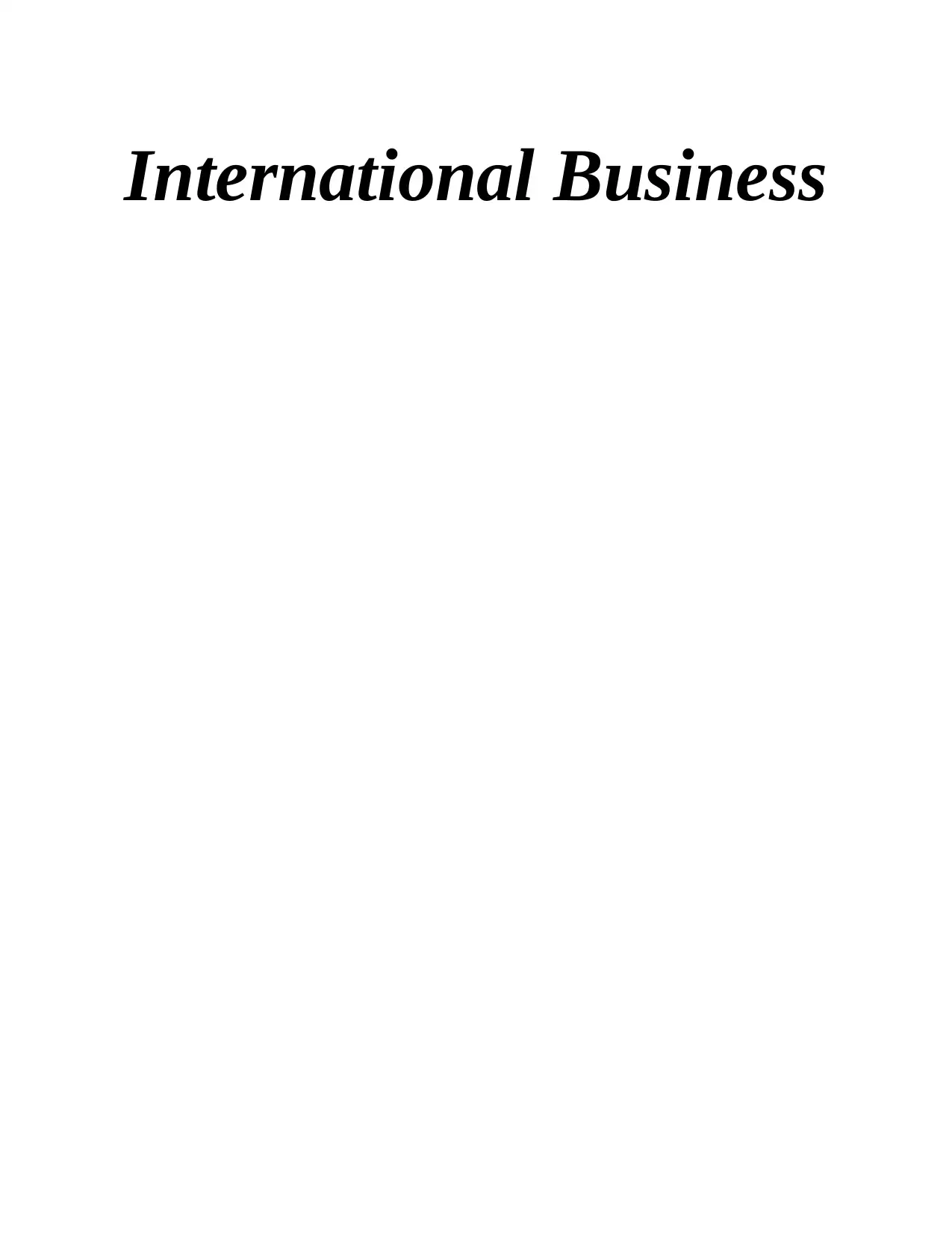
International Business
Secure Best Marks with AI Grader
Need help grading? Try our AI Grader for instant feedback on your assignments.
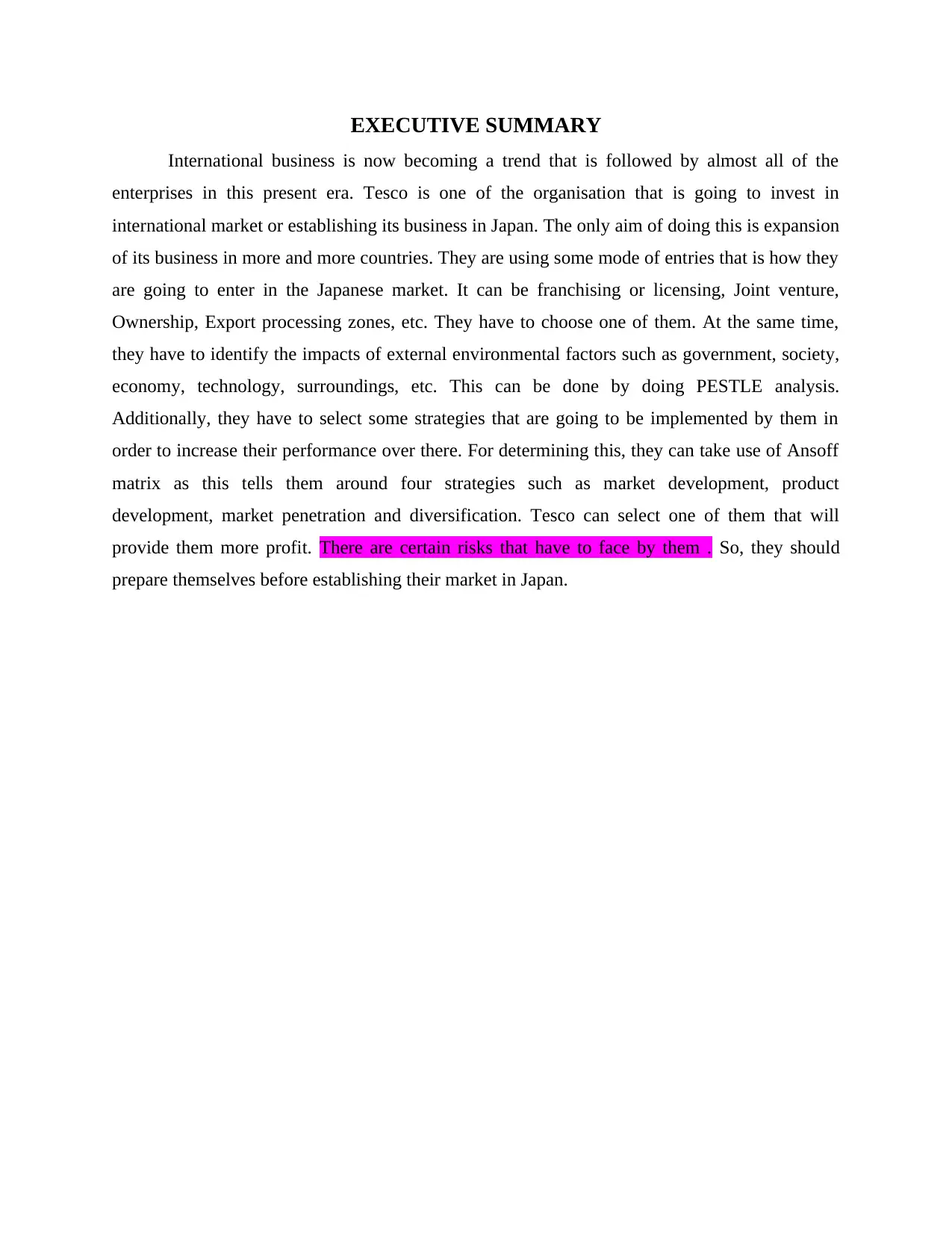
EXECUTIVE SUMMARY
International business is now becoming a trend that is followed by almost all of the
enterprises in this present era. Tesco is one of the organisation that is going to invest in
international market or establishing its business in Japan. The only aim of doing this is expansion
of its business in more and more countries. They are using some mode of entries that is how they
are going to enter in the Japanese market. It can be franchising or licensing, Joint venture,
Ownership, Export processing zones, etc. They have to choose one of them. At the same time,
they have to identify the impacts of external environmental factors such as government, society,
economy, technology, surroundings, etc. This can be done by doing PESTLE analysis.
Additionally, they have to select some strategies that are going to be implemented by them in
order to increase their performance over there. For determining this, they can take use of Ansoff
matrix as this tells them around four strategies such as market development, product
development, market penetration and diversification. Tesco can select one of them that will
provide them more profit. There are certain risks that have to face by them . So, they should
prepare themselves before establishing their market in Japan.
International business is now becoming a trend that is followed by almost all of the
enterprises in this present era. Tesco is one of the organisation that is going to invest in
international market or establishing its business in Japan. The only aim of doing this is expansion
of its business in more and more countries. They are using some mode of entries that is how they
are going to enter in the Japanese market. It can be franchising or licensing, Joint venture,
Ownership, Export processing zones, etc. They have to choose one of them. At the same time,
they have to identify the impacts of external environmental factors such as government, society,
economy, technology, surroundings, etc. This can be done by doing PESTLE analysis.
Additionally, they have to select some strategies that are going to be implemented by them in
order to increase their performance over there. For determining this, they can take use of Ansoff
matrix as this tells them around four strategies such as market development, product
development, market penetration and diversification. Tesco can select one of them that will
provide them more profit. There are certain risks that have to face by them . So, they should
prepare themselves before establishing their market in Japan.
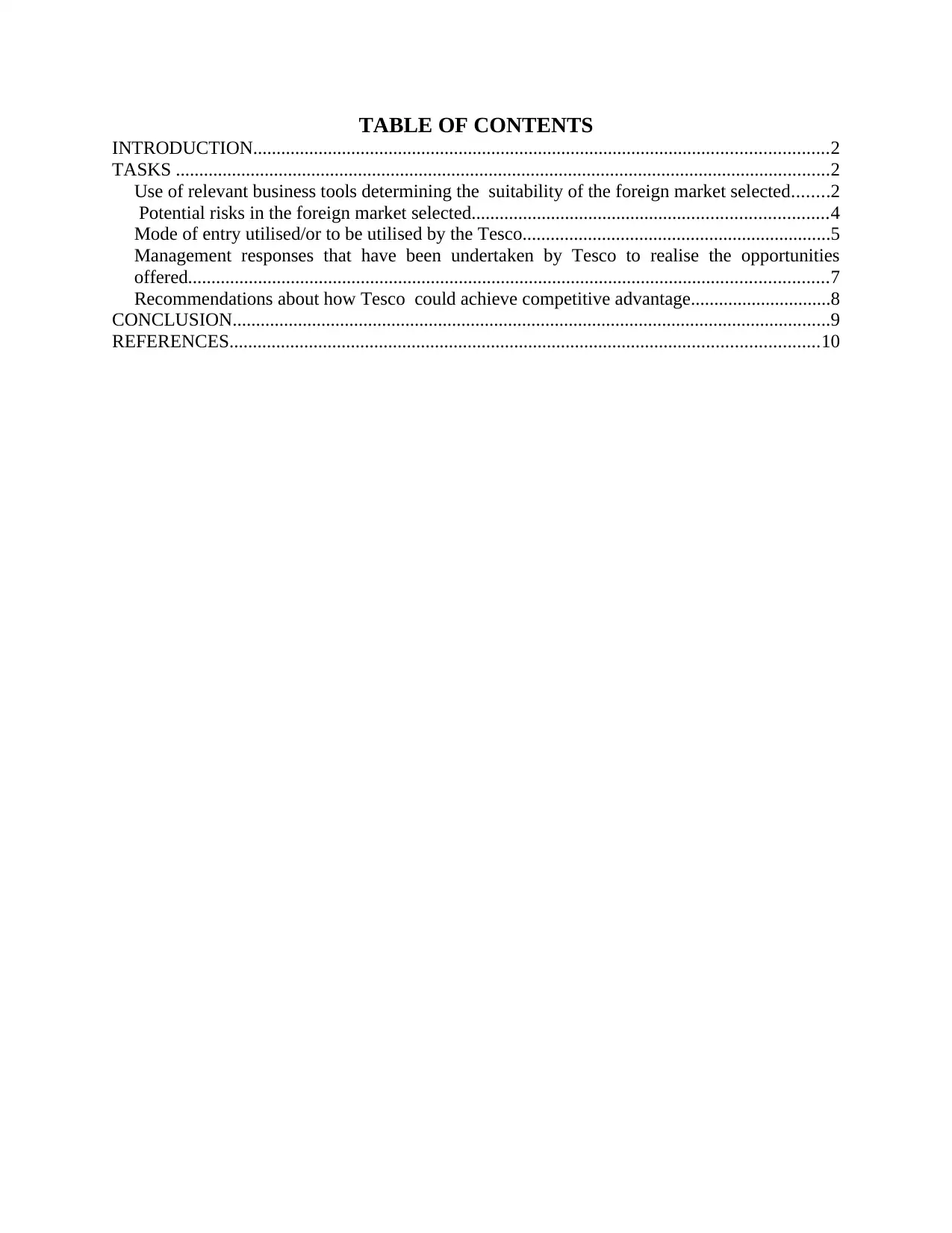
TABLE OF CONTENTS
INTRODUCTION...........................................................................................................................2
TASKS ............................................................................................................................................2
Use of relevant business tools determining the suitability of the foreign market selected........2
Potential risks in the foreign market selected............................................................................4
Mode of entry utilised/or to be utilised by the Tesco..................................................................5
Management responses that have been undertaken by Tesco to realise the opportunities
offered.........................................................................................................................................7
Recommendations about how Tesco could achieve competitive advantage..............................8
CONCLUSION................................................................................................................................9
REFERENCES..............................................................................................................................10
INTRODUCTION...........................................................................................................................2
TASKS ............................................................................................................................................2
Use of relevant business tools determining the suitability of the foreign market selected........2
Potential risks in the foreign market selected............................................................................4
Mode of entry utilised/or to be utilised by the Tesco..................................................................5
Management responses that have been undertaken by Tesco to realise the opportunities
offered.........................................................................................................................................7
Recommendations about how Tesco could achieve competitive advantage..............................8
CONCLUSION................................................................................................................................9
REFERENCES..............................................................................................................................10
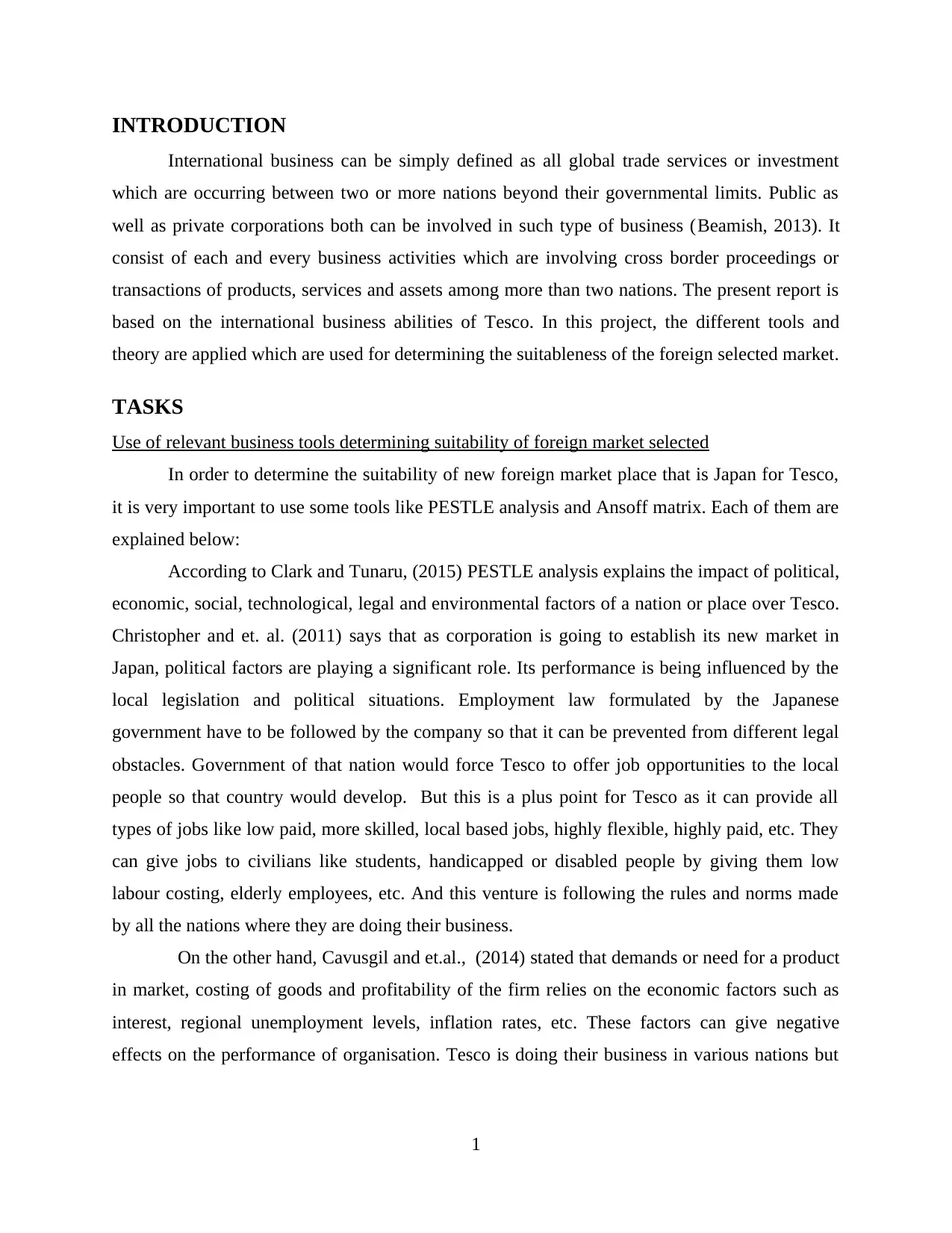
INTRODUCTION
International business can be simply defined as all global trade services or investment
which are occurring between two or more nations beyond their governmental limits. Public as
well as private corporations both can be involved in such type of business (Beamish, 2013). It
consist of each and every business activities which are involving cross border proceedings or
transactions of products, services and assets among more than two nations. The present report is
based on the international business abilities of Tesco. In this project, the different tools and
theory are applied which are used for determining the suitableness of the foreign selected market.
TASKS
Use of relevant business tools determining suitability of foreign market selected
In order to determine the suitability of new foreign market place that is Japan for Tesco,
it is very important to use some tools like PESTLE analysis and Ansoff matrix. Each of them are
explained below:
According to Clark and Tunaru, (2015) PESTLE analysis explains the impact of political,
economic, social, technological, legal and environmental factors of a nation or place over Tesco.
Christopher and et. al. (2011) says that as corporation is going to establish its new market in
Japan, political factors are playing a significant role. Its performance is being influenced by the
local legislation and political situations. Employment law formulated by the Japanese
government have to be followed by the company so that it can be prevented from different legal
obstacles. Government of that nation would force Tesco to offer job opportunities to the local
people so that country would develop. But this is a plus point for Tesco as it can provide all
types of jobs like low paid, more skilled, local based jobs, highly flexible, highly paid, etc. They
can give jobs to civilians like students, handicapped or disabled people by giving them low
labour costing, elderly employees, etc. And this venture is following the rules and norms made
by all the nations where they are doing their business.
On the other hand, Cavusgil and et.al., (2014) stated that demands or need for a product
in market, costing of goods and profitability of the firm relies on the economic factors such as
interest, regional unemployment levels, inflation rates, etc. These factors can give negative
effects on the performance of organisation. Tesco is doing their business in various nations but
1
International business can be simply defined as all global trade services or investment
which are occurring between two or more nations beyond their governmental limits. Public as
well as private corporations both can be involved in such type of business (Beamish, 2013). It
consist of each and every business activities which are involving cross border proceedings or
transactions of products, services and assets among more than two nations. The present report is
based on the international business abilities of Tesco. In this project, the different tools and
theory are applied which are used for determining the suitableness of the foreign selected market.
TASKS
Use of relevant business tools determining suitability of foreign market selected
In order to determine the suitability of new foreign market place that is Japan for Tesco,
it is very important to use some tools like PESTLE analysis and Ansoff matrix. Each of them are
explained below:
According to Clark and Tunaru, (2015) PESTLE analysis explains the impact of political,
economic, social, technological, legal and environmental factors of a nation or place over Tesco.
Christopher and et. al. (2011) says that as corporation is going to establish its new market in
Japan, political factors are playing a significant role. Its performance is being influenced by the
local legislation and political situations. Employment law formulated by the Japanese
government have to be followed by the company so that it can be prevented from different legal
obstacles. Government of that nation would force Tesco to offer job opportunities to the local
people so that country would develop. But this is a plus point for Tesco as it can provide all
types of jobs like low paid, more skilled, local based jobs, highly flexible, highly paid, etc. They
can give jobs to civilians like students, handicapped or disabled people by giving them low
labour costing, elderly employees, etc. And this venture is following the rules and norms made
by all the nations where they are doing their business.
On the other hand, Cavusgil and et.al., (2014) stated that demands or need for a product
in market, costing of goods and profitability of the firm relies on the economic factors such as
interest, regional unemployment levels, inflation rates, etc. These factors can give negative
effects on the performance of organisation. Tesco is doing their business in various nations but
1
Secure Best Marks with AI Grader
Need help grading? Try our AI Grader for instant feedback on your assignments.
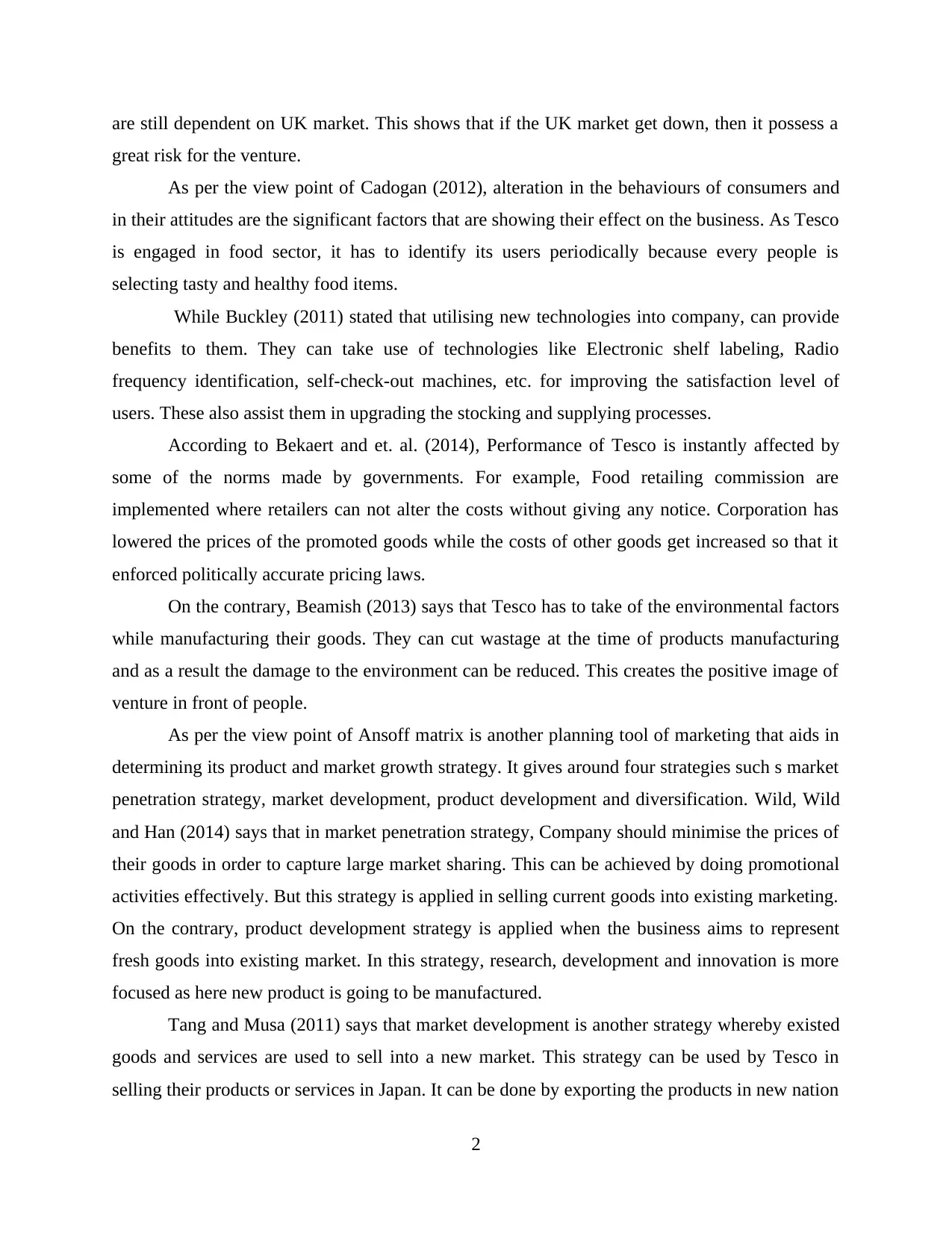
are still dependent on UK market. This shows that if the UK market get down, then it possess a
great risk for the venture.
As per the view point of Cadogan (2012), alteration in the behaviours of consumers and
in their attitudes are the significant factors that are showing their effect on the business. As Tesco
is engaged in food sector, it has to identify its users periodically because every people is
selecting tasty and healthy food items.
While Buckley (2011) stated that utilising new technologies into company, can provide
benefits to them. They can take use of technologies like Electronic shelf labeling, Radio
frequency identification, self-check-out machines, etc. for improving the satisfaction level of
users. These also assist them in upgrading the stocking and supplying processes.
According to Bekaert and et. al. (2014), Performance of Tesco is instantly affected by
some of the norms made by governments. For example, Food retailing commission are
implemented where retailers can not alter the costs without giving any notice. Corporation has
lowered the prices of the promoted goods while the costs of other goods get increased so that it
enforced politically accurate pricing laws.
On the contrary, Beamish (2013) says that Tesco has to take of the environmental factors
while manufacturing their goods. They can cut wastage at the time of products manufacturing
and as a result the damage to the environment can be reduced. This creates the positive image of
venture in front of people.
As per the view point of Ansoff matrix is another planning tool of marketing that aids in
determining its product and market growth strategy. It gives around four strategies such s market
penetration strategy, market development, product development and diversification. Wild, Wild
and Han (2014) says that in market penetration strategy, Company should minimise the prices of
their goods in order to capture large market sharing. This can be achieved by doing promotional
activities effectively. But this strategy is applied in selling current goods into existing marketing.
On the contrary, product development strategy is applied when the business aims to represent
fresh goods into existing market. In this strategy, research, development and innovation is more
focused as here new product is going to be manufactured.
Tang and Musa (2011) says that market development is another strategy whereby existed
goods and services are used to sell into a new market. This strategy can be used by Tesco in
selling their products or services in Japan. It can be done by exporting the products in new nation
2
great risk for the venture.
As per the view point of Cadogan (2012), alteration in the behaviours of consumers and
in their attitudes are the significant factors that are showing their effect on the business. As Tesco
is engaged in food sector, it has to identify its users periodically because every people is
selecting tasty and healthy food items.
While Buckley (2011) stated that utilising new technologies into company, can provide
benefits to them. They can take use of technologies like Electronic shelf labeling, Radio
frequency identification, self-check-out machines, etc. for improving the satisfaction level of
users. These also assist them in upgrading the stocking and supplying processes.
According to Bekaert and et. al. (2014), Performance of Tesco is instantly affected by
some of the norms made by governments. For example, Food retailing commission are
implemented where retailers can not alter the costs without giving any notice. Corporation has
lowered the prices of the promoted goods while the costs of other goods get increased so that it
enforced politically accurate pricing laws.
On the contrary, Beamish (2013) says that Tesco has to take of the environmental factors
while manufacturing their goods. They can cut wastage at the time of products manufacturing
and as a result the damage to the environment can be reduced. This creates the positive image of
venture in front of people.
As per the view point of Ansoff matrix is another planning tool of marketing that aids in
determining its product and market growth strategy. It gives around four strategies such s market
penetration strategy, market development, product development and diversification. Wild, Wild
and Han (2014) says that in market penetration strategy, Company should minimise the prices of
their goods in order to capture large market sharing. This can be achieved by doing promotional
activities effectively. But this strategy is applied in selling current goods into existing marketing.
On the contrary, product development strategy is applied when the business aims to represent
fresh goods into existing market. In this strategy, research, development and innovation is more
focused as here new product is going to be manufactured.
Tang and Musa (2011) says that market development is another strategy whereby existed
goods and services are used to sell into a new market. This strategy can be used by Tesco in
selling their products or services in Japan. It can be done by exporting the products in new nation
2
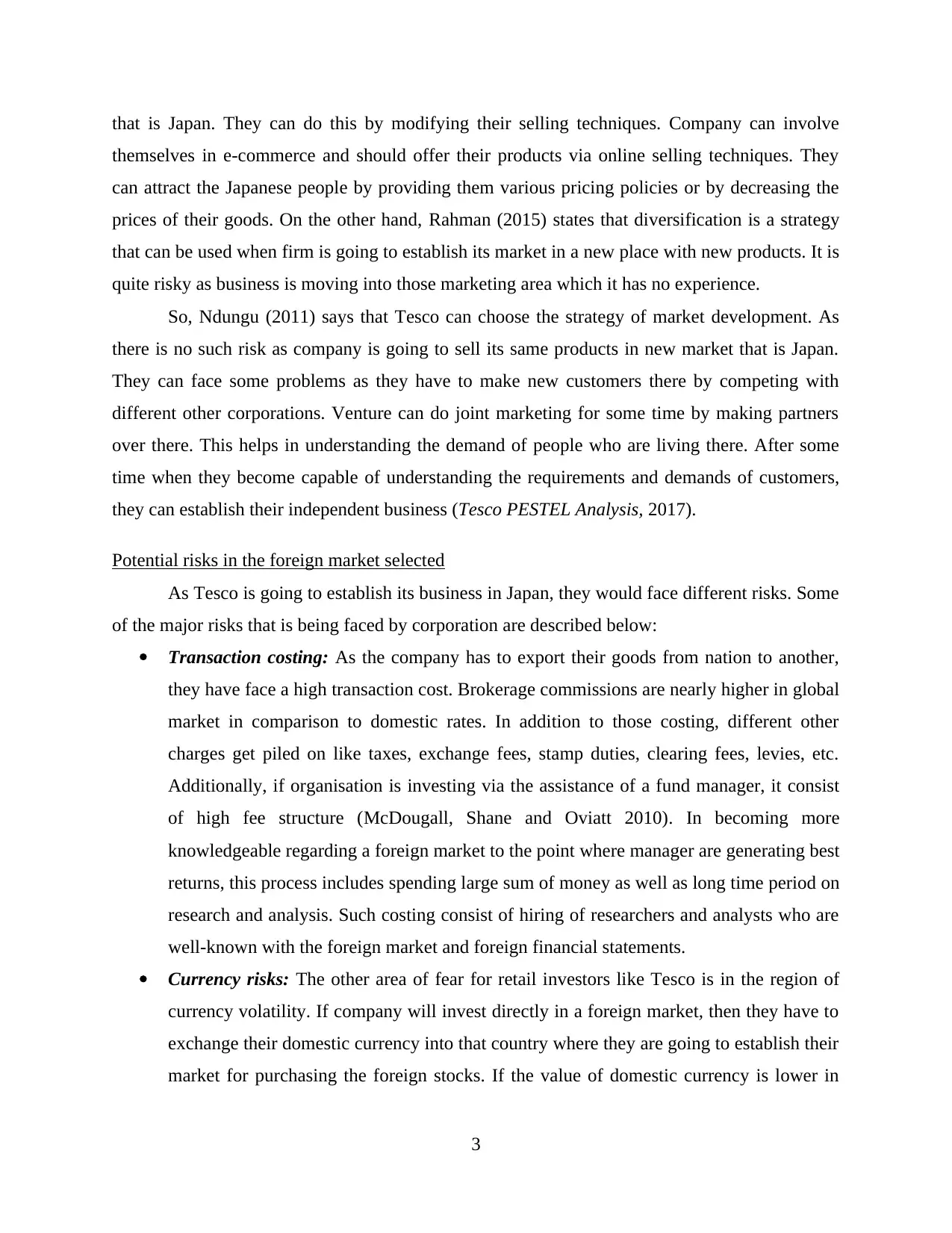
that is Japan. They can do this by modifying their selling techniques. Company can involve
themselves in e-commerce and should offer their products via online selling techniques. They
can attract the Japanese people by providing them various pricing policies or by decreasing the
prices of their goods. On the other hand, Rahman (2015) states that diversification is a strategy
that can be used when firm is going to establish its market in a new place with new products. It is
quite risky as business is moving into those marketing area which it has no experience.
So, Ndungu (2011) says that Tesco can choose the strategy of market development. As
there is no such risk as company is going to sell its same products in new market that is Japan.
They can face some problems as they have to make new customers there by competing with
different other corporations. Venture can do joint marketing for some time by making partners
over there. This helps in understanding the demand of people who are living there. After some
time when they become capable of understanding the requirements and demands of customers,
they can establish their independent business (Tesco PESTEL Analysis, 2017).
Potential risks in the foreign market selected
As Tesco is going to establish its business in Japan, they would face different risks. Some
of the major risks that is being faced by corporation are described below:
Transaction costing: As the company has to export their goods from nation to another,
they have face a high transaction cost. Brokerage commissions are nearly higher in global
market in comparison to domestic rates. In addition to those costing, different other
charges get piled on like taxes, exchange fees, stamp duties, clearing fees, levies, etc.
Additionally, if organisation is investing via the assistance of a fund manager, it consist
of high fee structure (McDougall, Shane and Oviatt 2010). In becoming more
knowledgeable regarding a foreign market to the point where manager are generating best
returns, this process includes spending large sum of money as well as long time period on
research and analysis. Such costing consist of hiring of researchers and analysts who are
well-known with the foreign market and foreign financial statements.
Currency risks: The other area of fear for retail investors like Tesco is in the region of
currency volatility. If company will invest directly in a foreign market, then they have to
exchange their domestic currency into that country where they are going to establish their
market for purchasing the foreign stocks. If the value of domestic currency is lower in
3
themselves in e-commerce and should offer their products via online selling techniques. They
can attract the Japanese people by providing them various pricing policies or by decreasing the
prices of their goods. On the other hand, Rahman (2015) states that diversification is a strategy
that can be used when firm is going to establish its market in a new place with new products. It is
quite risky as business is moving into those marketing area which it has no experience.
So, Ndungu (2011) says that Tesco can choose the strategy of market development. As
there is no such risk as company is going to sell its same products in new market that is Japan.
They can face some problems as they have to make new customers there by competing with
different other corporations. Venture can do joint marketing for some time by making partners
over there. This helps in understanding the demand of people who are living there. After some
time when they become capable of understanding the requirements and demands of customers,
they can establish their independent business (Tesco PESTEL Analysis, 2017).
Potential risks in the foreign market selected
As Tesco is going to establish its business in Japan, they would face different risks. Some
of the major risks that is being faced by corporation are described below:
Transaction costing: As the company has to export their goods from nation to another,
they have face a high transaction cost. Brokerage commissions are nearly higher in global
market in comparison to domestic rates. In addition to those costing, different other
charges get piled on like taxes, exchange fees, stamp duties, clearing fees, levies, etc.
Additionally, if organisation is investing via the assistance of a fund manager, it consist
of high fee structure (McDougall, Shane and Oviatt 2010). In becoming more
knowledgeable regarding a foreign market to the point where manager are generating best
returns, this process includes spending large sum of money as well as long time period on
research and analysis. Such costing consist of hiring of researchers and analysts who are
well-known with the foreign market and foreign financial statements.
Currency risks: The other area of fear for retail investors like Tesco is in the region of
currency volatility. If company will invest directly in a foreign market, then they have to
exchange their domestic currency into that country where they are going to establish their
market for purchasing the foreign stocks. If the value of domestic currency is lower in
3
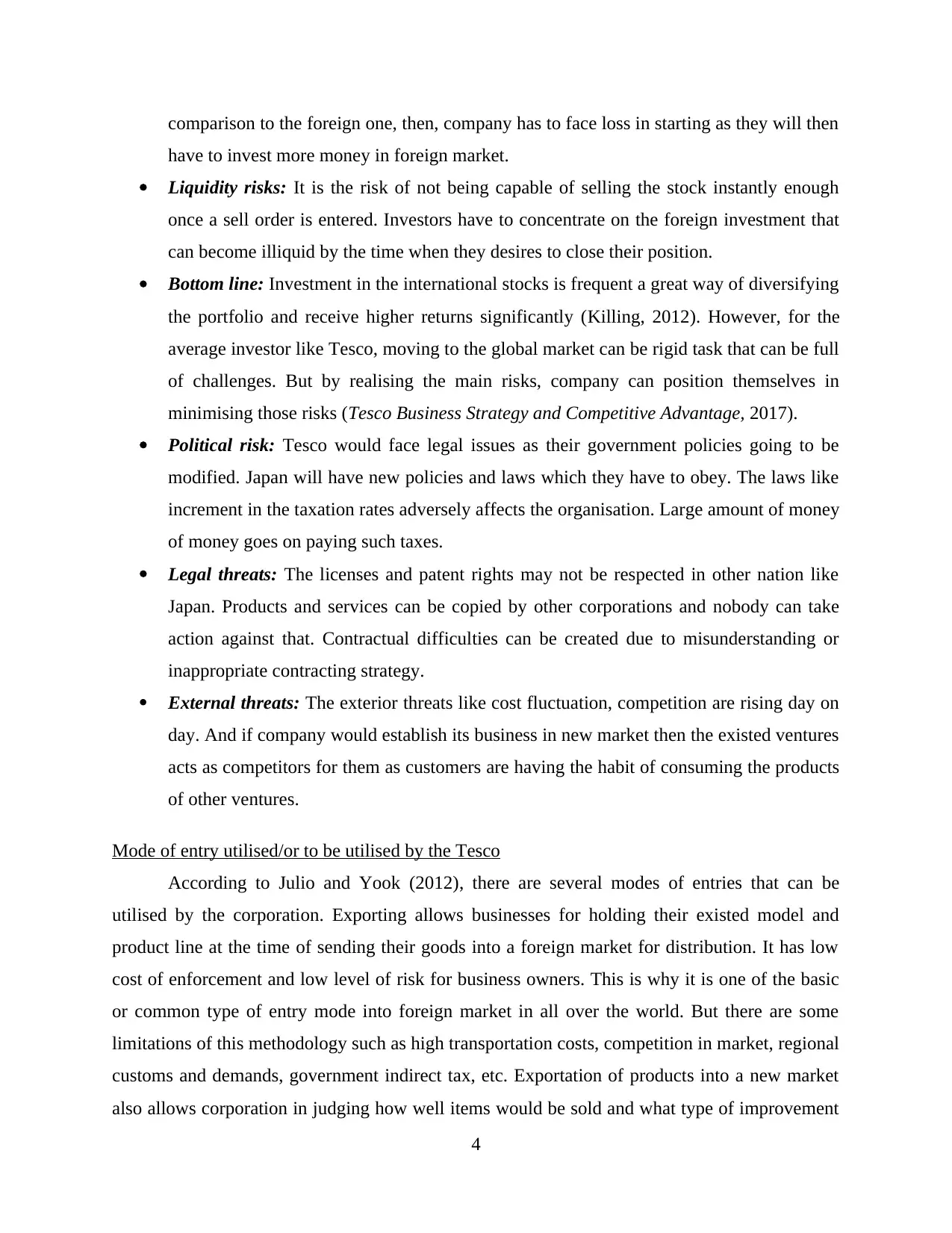
comparison to the foreign one, then, company has to face loss in starting as they will then
have to invest more money in foreign market.
Liquidity risks: It is the risk of not being capable of selling the stock instantly enough
once a sell order is entered. Investors have to concentrate on the foreign investment that
can become illiquid by the time when they desires to close their position.
Bottom line: Investment in the international stocks is frequent a great way of diversifying
the portfolio and receive higher returns significantly (Killing, 2012). However, for the
average investor like Tesco, moving to the global market can be rigid task that can be full
of challenges. But by realising the main risks, company can position themselves in
minimising those risks (Tesco Business Strategy and Competitive Advantage, 2017).
Political risk: Tesco would face legal issues as their government policies going to be
modified. Japan will have new policies and laws which they have to obey. The laws like
increment in the taxation rates adversely affects the organisation. Large amount of money
of money goes on paying such taxes.
Legal threats: The licenses and patent rights may not be respected in other nation like
Japan. Products and services can be copied by other corporations and nobody can take
action against that. Contractual difficulties can be created due to misunderstanding or
inappropriate contracting strategy.
External threats: The exterior threats like cost fluctuation, competition are rising day on
day. And if company would establish its business in new market then the existed ventures
acts as competitors for them as customers are having the habit of consuming the products
of other ventures.
Mode of entry utilised/or to be utilised by the Tesco
According to Julio and Yook (2012), there are several modes of entries that can be
utilised by the corporation. Exporting allows businesses for holding their existed model and
product line at the time of sending their goods into a foreign market for distribution. It has low
cost of enforcement and low level of risk for business owners. This is why it is one of the basic
or common type of entry mode into foreign market in all over the world. But there are some
limitations of this methodology such as high transportation costs, competition in market, regional
customs and demands, government indirect tax, etc. Exportation of products into a new market
also allows corporation in judging how well items would be sold and what type of improvement
4
have to invest more money in foreign market.
Liquidity risks: It is the risk of not being capable of selling the stock instantly enough
once a sell order is entered. Investors have to concentrate on the foreign investment that
can become illiquid by the time when they desires to close their position.
Bottom line: Investment in the international stocks is frequent a great way of diversifying
the portfolio and receive higher returns significantly (Killing, 2012). However, for the
average investor like Tesco, moving to the global market can be rigid task that can be full
of challenges. But by realising the main risks, company can position themselves in
minimising those risks (Tesco Business Strategy and Competitive Advantage, 2017).
Political risk: Tesco would face legal issues as their government policies going to be
modified. Japan will have new policies and laws which they have to obey. The laws like
increment in the taxation rates adversely affects the organisation. Large amount of money
of money goes on paying such taxes.
Legal threats: The licenses and patent rights may not be respected in other nation like
Japan. Products and services can be copied by other corporations and nobody can take
action against that. Contractual difficulties can be created due to misunderstanding or
inappropriate contracting strategy.
External threats: The exterior threats like cost fluctuation, competition are rising day on
day. And if company would establish its business in new market then the existed ventures
acts as competitors for them as customers are having the habit of consuming the products
of other ventures.
Mode of entry utilised/or to be utilised by the Tesco
According to Julio and Yook (2012), there are several modes of entries that can be
utilised by the corporation. Exporting allows businesses for holding their existed model and
product line at the time of sending their goods into a foreign market for distribution. It has low
cost of enforcement and low level of risk for business owners. This is why it is one of the basic
or common type of entry mode into foreign market in all over the world. But there are some
limitations of this methodology such as high transportation costs, competition in market, regional
customs and demands, government indirect tax, etc. Exportation of products into a new market
also allows corporation in judging how well items would be sold and what type of improvement
4
Paraphrase This Document
Need a fresh take? Get an instant paraphrase of this document with our AI Paraphraser
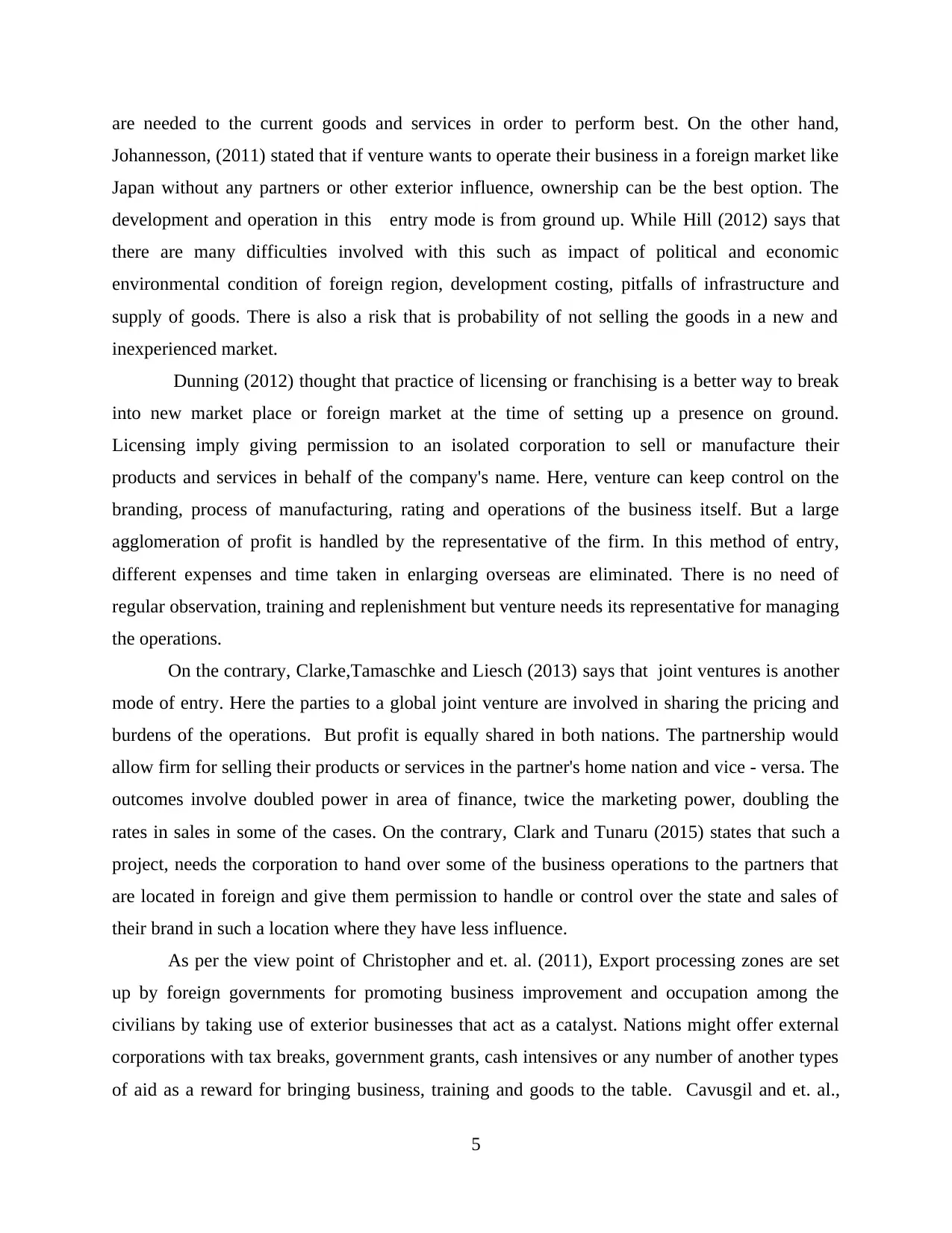
are needed to the current goods and services in order to perform best. On the other hand,
Johannesson, (2011) stated that if venture wants to operate their business in a foreign market like
Japan without any partners or other exterior influence, ownership can be the best option. The
development and operation in this entry mode is from ground up. While Hill (2012) says that
there are many difficulties involved with this such as impact of political and economic
environmental condition of foreign region, development costing, pitfalls of infrastructure and
supply of goods. There is also a risk that is probability of not selling the goods in a new and
inexperienced market.
Dunning (2012) thought that practice of licensing or franchising is a better way to break
into new market place or foreign market at the time of setting up a presence on ground.
Licensing imply giving permission to an isolated corporation to sell or manufacture their
products and services in behalf of the company's name. Here, venture can keep control on the
branding, process of manufacturing, rating and operations of the business itself. But a large
agglomeration of profit is handled by the representative of the firm. In this method of entry,
different expenses and time taken in enlarging overseas are eliminated. There is no need of
regular observation, training and replenishment but venture needs its representative for managing
the operations.
On the contrary, Clarke,Tamaschke and Liesch (2013) says that joint ventures is another
mode of entry. Here the parties to a global joint venture are involved in sharing the pricing and
burdens of the operations. But profit is equally shared in both nations. The partnership would
allow firm for selling their products or services in the partner's home nation and vice - versa. The
outcomes involve doubled power in area of finance, twice the marketing power, doubling the
rates in sales in some of the cases. On the contrary, Clark and Tunaru (2015) states that such a
project, needs the corporation to hand over some of the business operations to the partners that
are located in foreign and give them permission to handle or control over the state and sales of
their brand in such a location where they have less influence.
As per the view point of Christopher and et. al. (2011), Export processing zones are set
up by foreign governments for promoting business improvement and occupation among the
civilians by taking use of exterior businesses that act as a catalyst. Nations might offer external
corporations with tax breaks, government grants, cash intensives or any number of another types
of aid as a reward for bringing business, training and goods to the table. Cavusgil and et. al.,
5
Johannesson, (2011) stated that if venture wants to operate their business in a foreign market like
Japan without any partners or other exterior influence, ownership can be the best option. The
development and operation in this entry mode is from ground up. While Hill (2012) says that
there are many difficulties involved with this such as impact of political and economic
environmental condition of foreign region, development costing, pitfalls of infrastructure and
supply of goods. There is also a risk that is probability of not selling the goods in a new and
inexperienced market.
Dunning (2012) thought that practice of licensing or franchising is a better way to break
into new market place or foreign market at the time of setting up a presence on ground.
Licensing imply giving permission to an isolated corporation to sell or manufacture their
products and services in behalf of the company's name. Here, venture can keep control on the
branding, process of manufacturing, rating and operations of the business itself. But a large
agglomeration of profit is handled by the representative of the firm. In this method of entry,
different expenses and time taken in enlarging overseas are eliminated. There is no need of
regular observation, training and replenishment but venture needs its representative for managing
the operations.
On the contrary, Clarke,Tamaschke and Liesch (2013) says that joint ventures is another
mode of entry. Here the parties to a global joint venture are involved in sharing the pricing and
burdens of the operations. But profit is equally shared in both nations. The partnership would
allow firm for selling their products or services in the partner's home nation and vice - versa. The
outcomes involve doubled power in area of finance, twice the marketing power, doubling the
rates in sales in some of the cases. On the contrary, Clark and Tunaru (2015) states that such a
project, needs the corporation to hand over some of the business operations to the partners that
are located in foreign and give them permission to handle or control over the state and sales of
their brand in such a location where they have less influence.
As per the view point of Christopher and et. al. (2011), Export processing zones are set
up by foreign governments for promoting business improvement and occupation among the
civilians by taking use of exterior businesses that act as a catalyst. Nations might offer external
corporations with tax breaks, government grants, cash intensives or any number of another types
of aid as a reward for bringing business, training and goods to the table. Cavusgil and et. al.,
5
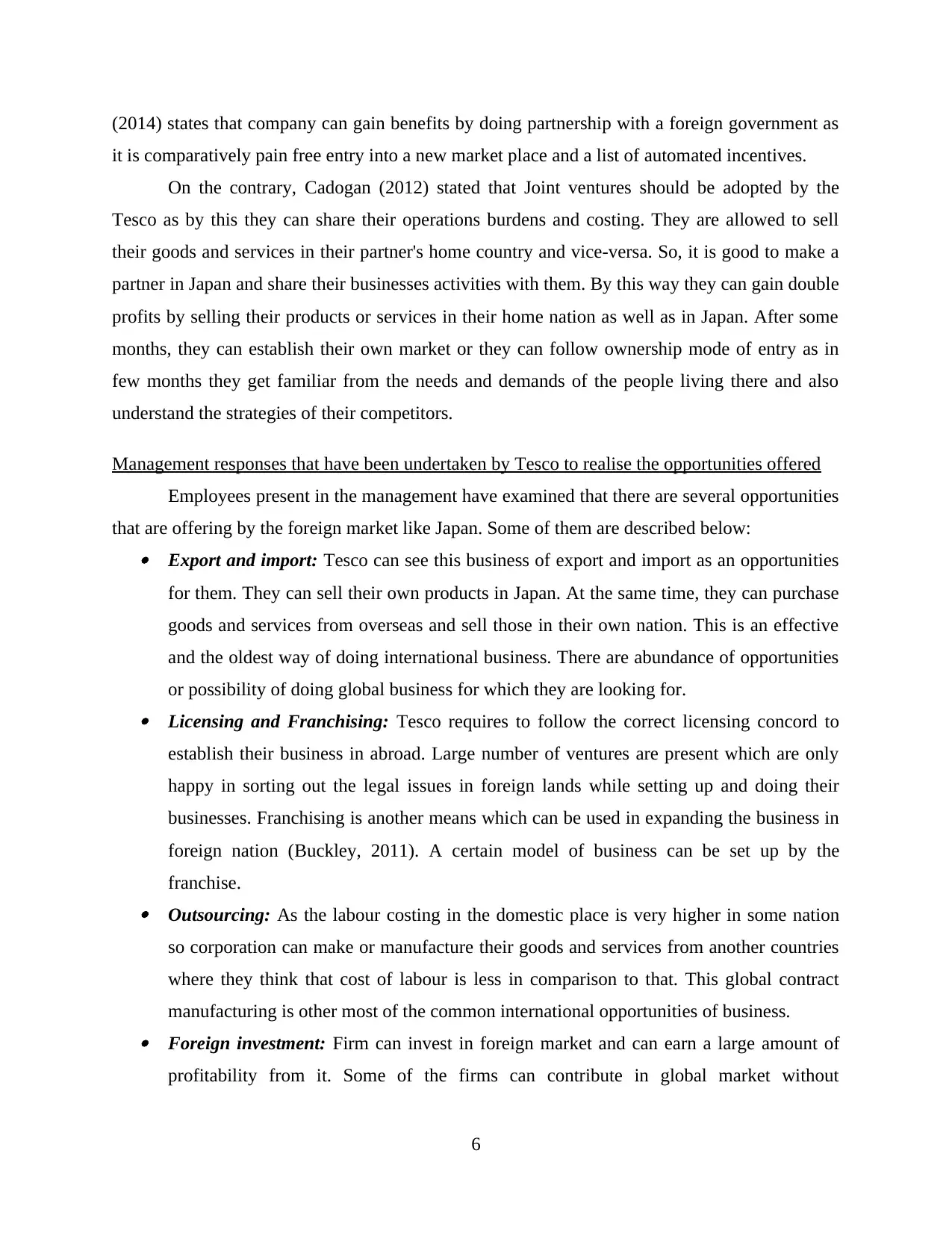
(2014) states that company can gain benefits by doing partnership with a foreign government as
it is comparatively pain free entry into a new market place and a list of automated incentives.
On the contrary, Cadogan (2012) stated that Joint ventures should be adopted by the
Tesco as by this they can share their operations burdens and costing. They are allowed to sell
their goods and services in their partner's home country and vice-versa. So, it is good to make a
partner in Japan and share their businesses activities with them. By this way they can gain double
profits by selling their products or services in their home nation as well as in Japan. After some
months, they can establish their own market or they can follow ownership mode of entry as in
few months they get familiar from the needs and demands of the people living there and also
understand the strategies of their competitors.
Management responses that have been undertaken by Tesco to realise the opportunities offered
Employees present in the management have examined that there are several opportunities
that are offering by the foreign market like Japan. Some of them are described below: Export and import: Tesco can see this business of export and import as an opportunities
for them. They can sell their own products in Japan. At the same time, they can purchase
goods and services from overseas and sell those in their own nation. This is an effective
and the oldest way of doing international business. There are abundance of opportunities
or possibility of doing global business for which they are looking for. Licensing and Franchising: Tesco requires to follow the correct licensing concord to
establish their business in abroad. Large number of ventures are present which are only
happy in sorting out the legal issues in foreign lands while setting up and doing their
businesses. Franchising is another means which can be used in expanding the business in
foreign nation (Buckley, 2011). A certain model of business can be set up by the
franchise. Outsourcing: As the labour costing in the domestic place is very higher in some nation
so corporation can make or manufacture their goods and services from another countries
where they think that cost of labour is less in comparison to that. This global contract
manufacturing is other most of the common international opportunities of business. Foreign investment: Firm can invest in foreign market and can earn a large amount of
profitability from it. Some of the firms can contribute in global market without
6
it is comparatively pain free entry into a new market place and a list of automated incentives.
On the contrary, Cadogan (2012) stated that Joint ventures should be adopted by the
Tesco as by this they can share their operations burdens and costing. They are allowed to sell
their goods and services in their partner's home country and vice-versa. So, it is good to make a
partner in Japan and share their businesses activities with them. By this way they can gain double
profits by selling their products or services in their home nation as well as in Japan. After some
months, they can establish their own market or they can follow ownership mode of entry as in
few months they get familiar from the needs and demands of the people living there and also
understand the strategies of their competitors.
Management responses that have been undertaken by Tesco to realise the opportunities offered
Employees present in the management have examined that there are several opportunities
that are offering by the foreign market like Japan. Some of them are described below: Export and import: Tesco can see this business of export and import as an opportunities
for them. They can sell their own products in Japan. At the same time, they can purchase
goods and services from overseas and sell those in their own nation. This is an effective
and the oldest way of doing international business. There are abundance of opportunities
or possibility of doing global business for which they are looking for. Licensing and Franchising: Tesco requires to follow the correct licensing concord to
establish their business in abroad. Large number of ventures are present which are only
happy in sorting out the legal issues in foreign lands while setting up and doing their
businesses. Franchising is another means which can be used in expanding the business in
foreign nation (Buckley, 2011). A certain model of business can be set up by the
franchise. Outsourcing: As the labour costing in the domestic place is very higher in some nation
so corporation can make or manufacture their goods and services from another countries
where they think that cost of labour is less in comparison to that. This global contract
manufacturing is other most of the common international opportunities of business. Foreign investment: Firm can invest in foreign market and can earn a large amount of
profitability from it. Some of the firms can contribute in global market without
6
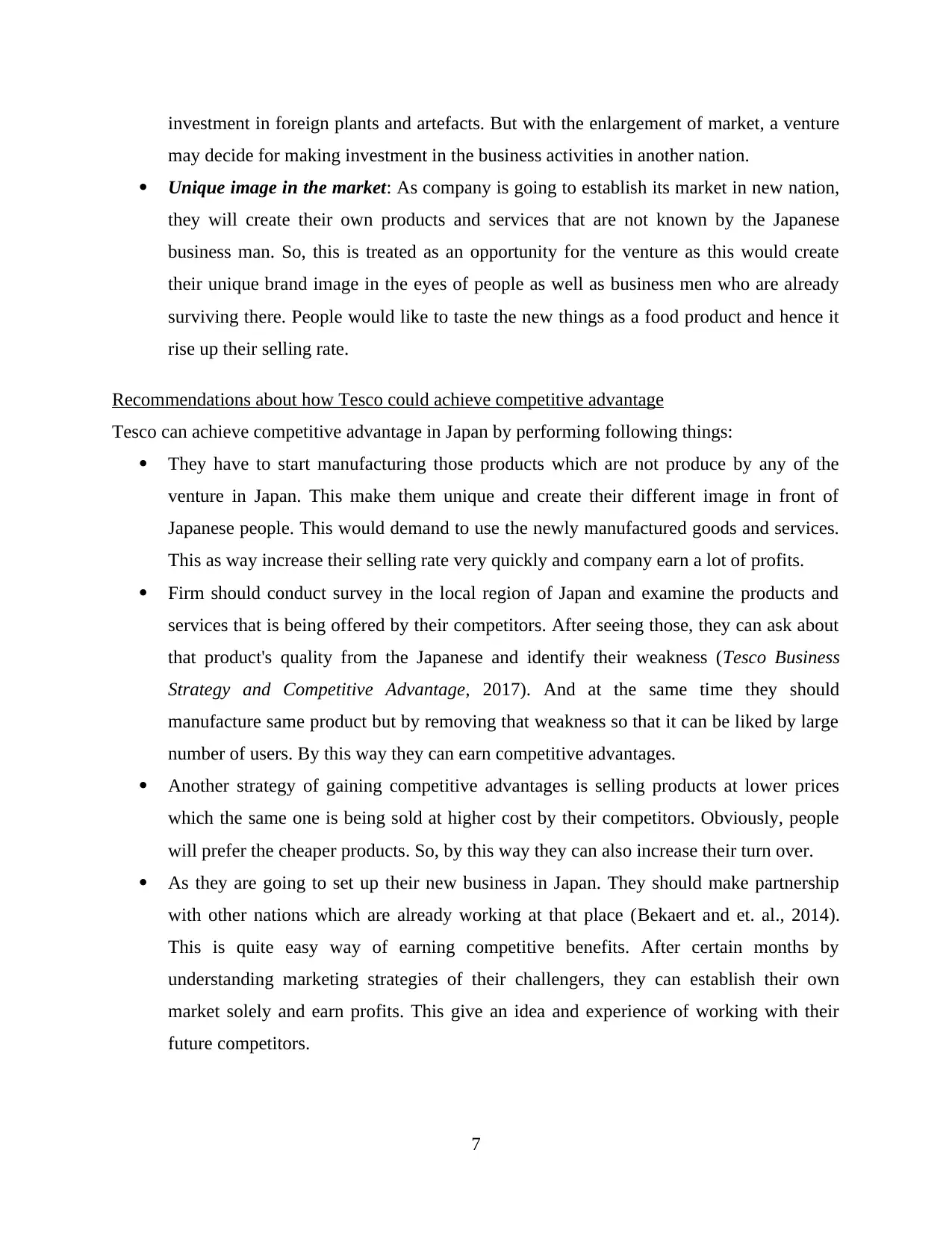
investment in foreign plants and artefacts. But with the enlargement of market, a venture
may decide for making investment in the business activities in another nation.
Unique image in the market: As company is going to establish its market in new nation,
they will create their own products and services that are not known by the Japanese
business man. So, this is treated as an opportunity for the venture as this would create
their unique brand image in the eyes of people as well as business men who are already
surviving there. People would like to taste the new things as a food product and hence it
rise up their selling rate.
Recommendations about how Tesco could achieve competitive advantage
Tesco can achieve competitive advantage in Japan by performing following things:
They have to start manufacturing those products which are not produce by any of the
venture in Japan. This make them unique and create their different image in front of
Japanese people. This would demand to use the newly manufactured goods and services.
This as way increase their selling rate very quickly and company earn a lot of profits.
Firm should conduct survey in the local region of Japan and examine the products and
services that is being offered by their competitors. After seeing those, they can ask about
that product's quality from the Japanese and identify their weakness (Tesco Business
Strategy and Competitive Advantage, 2017). And at the same time they should
manufacture same product but by removing that weakness so that it can be liked by large
number of users. By this way they can earn competitive advantages.
Another strategy of gaining competitive advantages is selling products at lower prices
which the same one is being sold at higher cost by their competitors. Obviously, people
will prefer the cheaper products. So, by this way they can also increase their turn over.
As they are going to set up their new business in Japan. They should make partnership
with other nations which are already working at that place (Bekaert and et. al., 2014).
This is quite easy way of earning competitive benefits. After certain months by
understanding marketing strategies of their challengers, they can establish their own
market solely and earn profits. This give an idea and experience of working with their
future competitors.
7
may decide for making investment in the business activities in another nation.
Unique image in the market: As company is going to establish its market in new nation,
they will create their own products and services that are not known by the Japanese
business man. So, this is treated as an opportunity for the venture as this would create
their unique brand image in the eyes of people as well as business men who are already
surviving there. People would like to taste the new things as a food product and hence it
rise up their selling rate.
Recommendations about how Tesco could achieve competitive advantage
Tesco can achieve competitive advantage in Japan by performing following things:
They have to start manufacturing those products which are not produce by any of the
venture in Japan. This make them unique and create their different image in front of
Japanese people. This would demand to use the newly manufactured goods and services.
This as way increase their selling rate very quickly and company earn a lot of profits.
Firm should conduct survey in the local region of Japan and examine the products and
services that is being offered by their competitors. After seeing those, they can ask about
that product's quality from the Japanese and identify their weakness (Tesco Business
Strategy and Competitive Advantage, 2017). And at the same time they should
manufacture same product but by removing that weakness so that it can be liked by large
number of users. By this way they can earn competitive advantages.
Another strategy of gaining competitive advantages is selling products at lower prices
which the same one is being sold at higher cost by their competitors. Obviously, people
will prefer the cheaper products. So, by this way they can also increase their turn over.
As they are going to set up their new business in Japan. They should make partnership
with other nations which are already working at that place (Bekaert and et. al., 2014).
This is quite easy way of earning competitive benefits. After certain months by
understanding marketing strategies of their challengers, they can establish their own
market solely and earn profits. This give an idea and experience of working with their
future competitors.
7
Secure Best Marks with AI Grader
Need help grading? Try our AI Grader for instant feedback on your assignments.
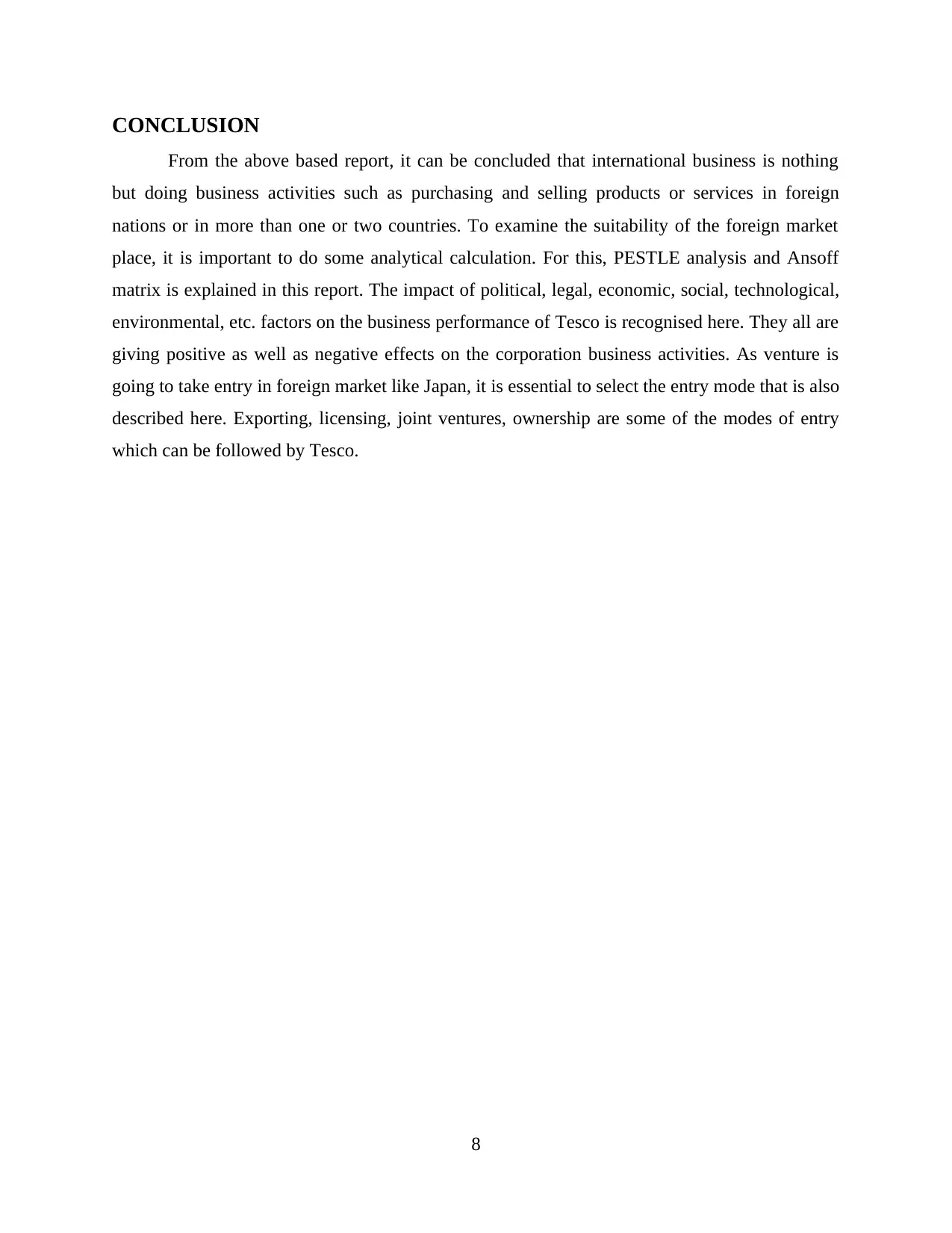
CONCLUSION
From the above based report, it can be concluded that international business is nothing
but doing business activities such as purchasing and selling products or services in foreign
nations or in more than one or two countries. To examine the suitability of the foreign market
place, it is important to do some analytical calculation. For this, PESTLE analysis and Ansoff
matrix is explained in this report. The impact of political, legal, economic, social, technological,
environmental, etc. factors on the business performance of Tesco is recognised here. They all are
giving positive as well as negative effects on the corporation business activities. As venture is
going to take entry in foreign market like Japan, it is essential to select the entry mode that is also
described here. Exporting, licensing, joint ventures, ownership are some of the modes of entry
which can be followed by Tesco.
8
From the above based report, it can be concluded that international business is nothing
but doing business activities such as purchasing and selling products or services in foreign
nations or in more than one or two countries. To examine the suitability of the foreign market
place, it is important to do some analytical calculation. For this, PESTLE analysis and Ansoff
matrix is explained in this report. The impact of political, legal, economic, social, technological,
environmental, etc. factors on the business performance of Tesco is recognised here. They all are
giving positive as well as negative effects on the corporation business activities. As venture is
going to take entry in foreign market like Japan, it is essential to select the entry mode that is also
described here. Exporting, licensing, joint ventures, ownership are some of the modes of entry
which can be followed by Tesco.
8
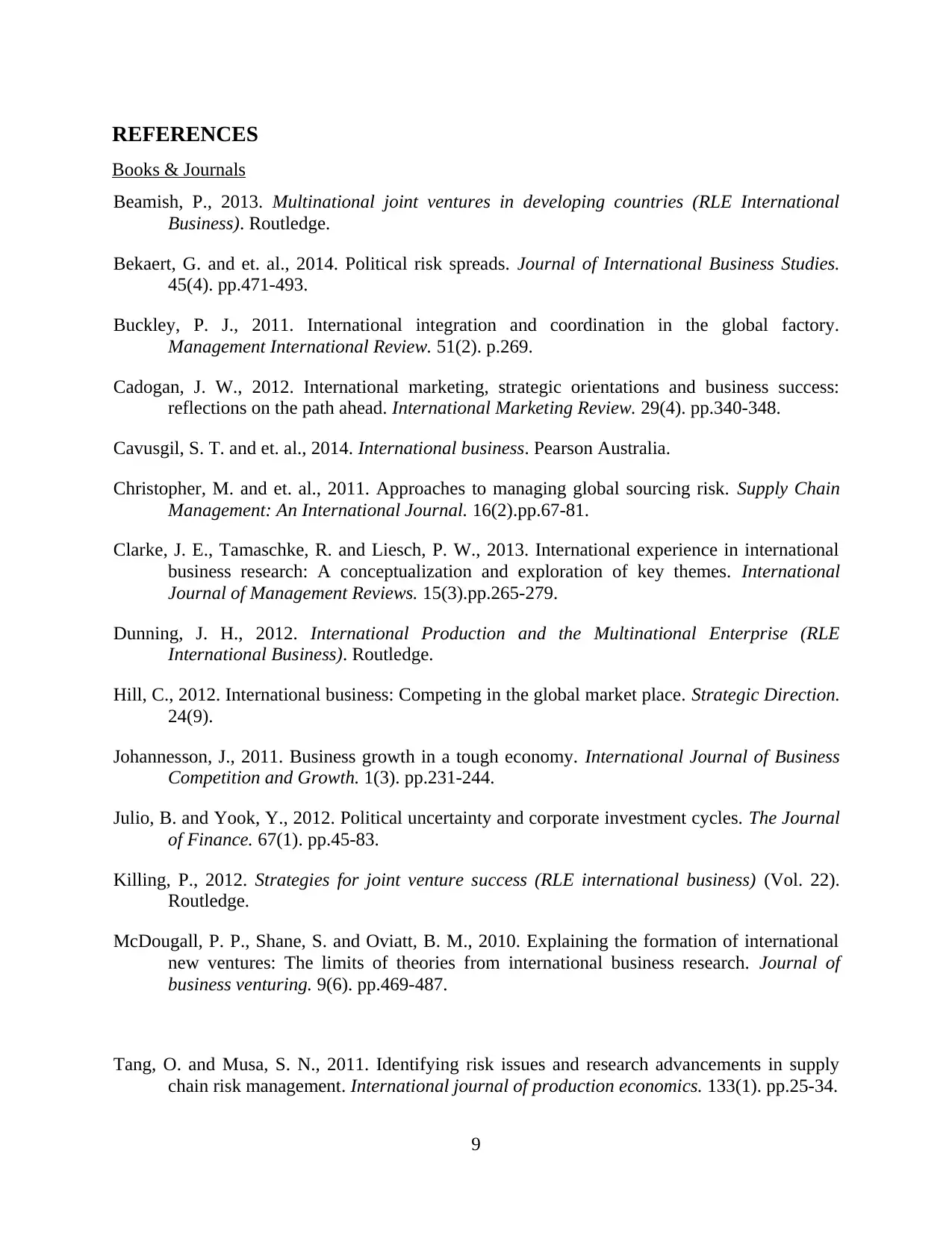
REFERENCES
Books & Journals
Beamish, P., 2013. Multinational joint ventures in developing countries (RLE International
Business). Routledge.
Bekaert, G. and et. al., 2014. Political risk spreads. Journal of International Business Studies.
45(4). pp.471-493.
Buckley, P. J., 2011. International integration and coordination in the global factory.
Management International Review. 51(2). p.269.
Cadogan, J. W., 2012. International marketing, strategic orientations and business success:
reflections on the path ahead. International Marketing Review. 29(4). pp.340-348.
Cavusgil, S. T. and et. al., 2014. International business. Pearson Australia.
Christopher, M. and et. al., 2011. Approaches to managing global sourcing risk. Supply Chain
Management: An International Journal. 16(2).pp.67-81.
Clarke, J. E., Tamaschke, R. and Liesch, P. W., 2013. International experience in international
business research: A conceptualization and exploration of key themes. International
Journal of Management Reviews. 15(3).pp.265-279.
Dunning, J. H., 2012. International Production and the Multinational Enterprise (RLE
International Business). Routledge.
Hill, C., 2012. International business: Competing in the global market place. Strategic Direction.
24(9).
Johannesson, J., 2011. Business growth in a tough economy. International Journal of Business
Competition and Growth. 1(3). pp.231-244.
Julio, B. and Yook, Y., 2012. Political uncertainty and corporate investment cycles. The Journal
of Finance. 67(1). pp.45-83.
Killing, P., 2012. Strategies for joint venture success (RLE international business) (Vol. 22).
Routledge.
McDougall, P. P., Shane, S. and Oviatt, B. M., 2010. Explaining the formation of international
new ventures: The limits of theories from international business research. Journal of
business venturing. 9(6). pp.469-487.
Tang, O. and Musa, S. N., 2011. Identifying risk issues and research advancements in supply
chain risk management. International journal of production economics. 133(1). pp.25-34.
9
Books & Journals
Beamish, P., 2013. Multinational joint ventures in developing countries (RLE International
Business). Routledge.
Bekaert, G. and et. al., 2014. Political risk spreads. Journal of International Business Studies.
45(4). pp.471-493.
Buckley, P. J., 2011. International integration and coordination in the global factory.
Management International Review. 51(2). p.269.
Cadogan, J. W., 2012. International marketing, strategic orientations and business success:
reflections on the path ahead. International Marketing Review. 29(4). pp.340-348.
Cavusgil, S. T. and et. al., 2014. International business. Pearson Australia.
Christopher, M. and et. al., 2011. Approaches to managing global sourcing risk. Supply Chain
Management: An International Journal. 16(2).pp.67-81.
Clarke, J. E., Tamaschke, R. and Liesch, P. W., 2013. International experience in international
business research: A conceptualization and exploration of key themes. International
Journal of Management Reviews. 15(3).pp.265-279.
Dunning, J. H., 2012. International Production and the Multinational Enterprise (RLE
International Business). Routledge.
Hill, C., 2012. International business: Competing in the global market place. Strategic Direction.
24(9).
Johannesson, J., 2011. Business growth in a tough economy. International Journal of Business
Competition and Growth. 1(3). pp.231-244.
Julio, B. and Yook, Y., 2012. Political uncertainty and corporate investment cycles. The Journal
of Finance. 67(1). pp.45-83.
Killing, P., 2012. Strategies for joint venture success (RLE international business) (Vol. 22).
Routledge.
McDougall, P. P., Shane, S. and Oviatt, B. M., 2010. Explaining the formation of international
new ventures: The limits of theories from international business research. Journal of
business venturing. 9(6). pp.469-487.
Tang, O. and Musa, S. N., 2011. Identifying risk issues and research advancements in supply
chain risk management. International journal of production economics. 133(1). pp.25-34.
9
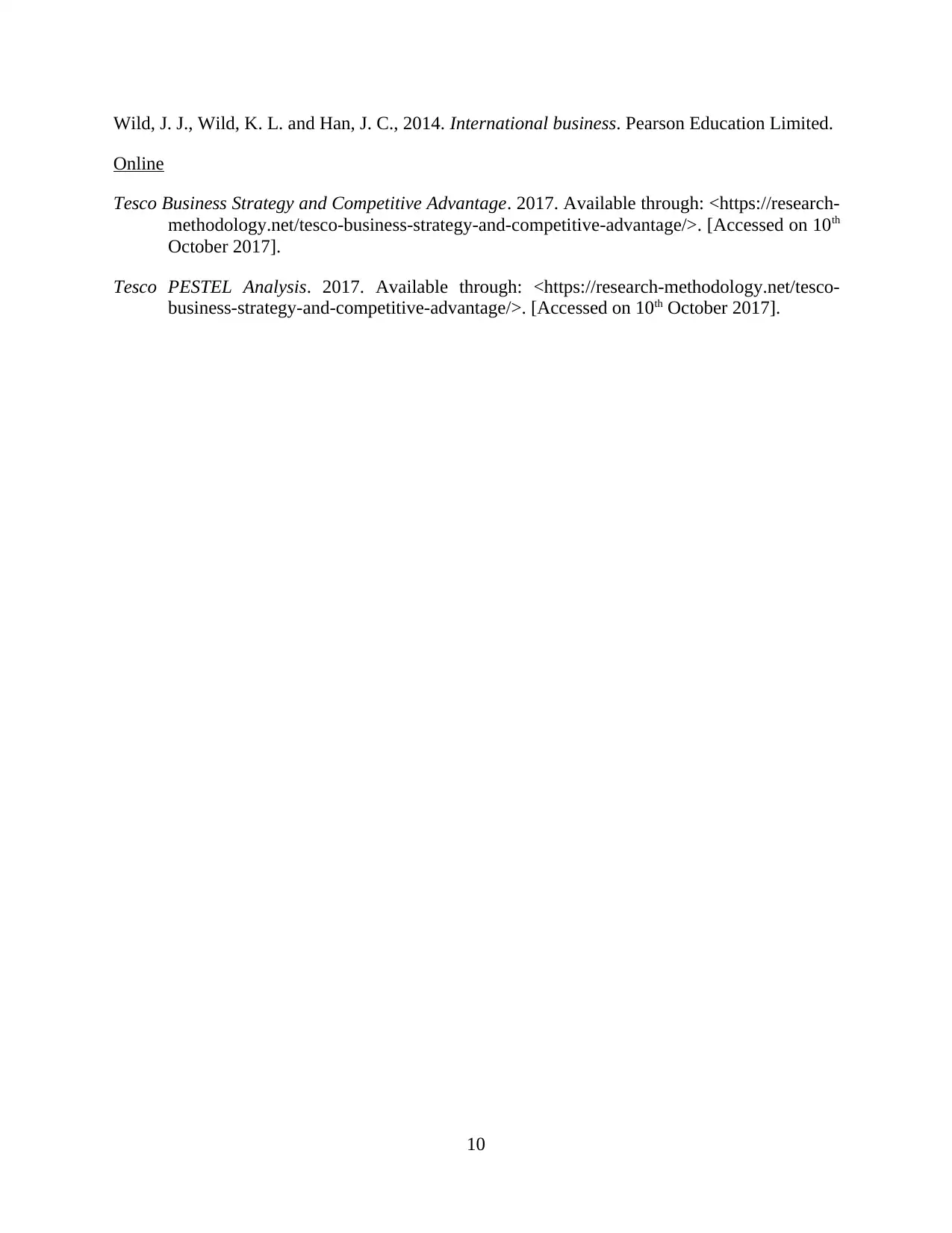
Wild, J. J., Wild, K. L. and Han, J. C., 2014. International business. Pearson Education Limited.
Online
Tesco Business Strategy and Competitive Advantage. 2017. Available through: <https://research-
methodology.net/tesco-business-strategy-and-competitive-advantage/>. [Accessed on 10th
October 2017].
Tesco PESTEL Analysis. 2017. Available through: <https://research-methodology.net/tesco-
business-strategy-and-competitive-advantage/>. [Accessed on 10th October 2017].
10
Online
Tesco Business Strategy and Competitive Advantage. 2017. Available through: <https://research-
methodology.net/tesco-business-strategy-and-competitive-advantage/>. [Accessed on 10th
October 2017].
Tesco PESTEL Analysis. 2017. Available through: <https://research-methodology.net/tesco-
business-strategy-and-competitive-advantage/>. [Accessed on 10th October 2017].
10
1 out of 13
Related Documents
Your All-in-One AI-Powered Toolkit for Academic Success.
+13062052269
info@desklib.com
Available 24*7 on WhatsApp / Email
![[object Object]](/_next/static/media/star-bottom.7253800d.svg)
Unlock your academic potential
© 2024 | Zucol Services PVT LTD | All rights reserved.





